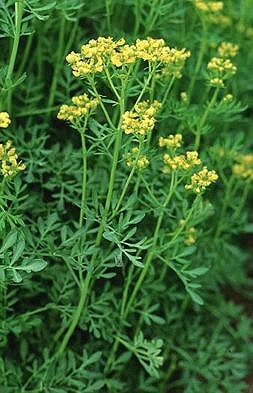October
2007
Did you konw that the plant Rue has been used as a medicinal and "antimagic" herb for centuries and it was
considered a reliable defense against witches?

|
|
Rue
- Ruta graveolens
|
Rue - Ruta graveolens
Rue (Ruta) is a genus of strongly scented
evergreen subshrubs 20-90 cm tall, in the family Rutaceae,
native to the Mediterranean region, Macronesia and southwest Asia. Different
authors accept between 8-40 species in the genus. The most well-known species is
the Common Rue (Ruta graveolens).
Rue is a small evergreen subshrub or semiwoody perennial 2-3 ft
(0.6-0.9 m) tall and almost as wide. The stems become woody near the base, but
remain herbaceous nearer the tips. The 3-5 ft (7.6-12.7 cm) long leaves are
dissected pinnately into oblong or spoon shaped segments. They are somewhat
fleshy and usually covered with a powdery bloom. The sea green foliage has a
strong, pungent, rather unpleasant scent when bruised. The clusters of small
yellow flowers appear in midsummer, held well above the foliage and often
covering most of the plant. The fruit is a 4-5 lobed capsule, containing numerous
seeds.
Common rue is native to southern Europe and northern
Africa. It is apparently no
longer found in the wild, but occasionally escapes from gardens and naturalizes
along roadsides and waste areas in North America and Europe, especially in the
Balkans. Rue is a standout in the herb garden. It's often included in herb gardens just for its historical
interest.
Rue responds well to pruning - it can be shaped into a rounded mass and used in
borders and beds, where it goes well with light colored flowers.
Plants can be grown
for ground cover when planted about 45cm apart each way.
Propagation from seeds
or cuttings. Seed - best sown as soon as it is ripe in a cold frame, it can also be sown in
early to mid spring in a cold frame. When they are large enough to handle, prick
the seedlings out into individual pots and grow them on in the greenhouse for
their first winter. Plant them out into their permanent positions in late spring
or early summer, after the last expected frosts. Cuttings of young shoots in
late spring.
It is said that the rue stolen from your neighbor's garden will grow
best.
The growing or the dried plant can be used to repel
insects, it is most useful
when the plant is grown near roses and raspberries. The dried herb can also be
put in the linen cupboard to repel moths. The growing plant is also said to
repel cats. A red dye is obtained from the plant. An essential oil is obtained
from the leaves and young shoots, it is used in perfumery and as a food
flavouring.
It was used extensively in Middle Eastern cuisine in olden
days, as well as in
many ancient Greek and Roman recipes (according to
Apicius), but because it is very bitter,
it is usually not suitable for most modern tastes. However, it is still used in
certain parts of the world, particularly in northern Africa.
Rue has been used as a medicinal and "antimagic" herb for
centuries. It was
considered a reliable defense against witches. Rue
in some sources, it is the famous "moly plant" used by
Ulysses in The Odyssey (book 10, lines 304-6) to protect himself and his men
from the spell of the Circe.
Gunflints boiled in a mixture of
rue and vervain were said improve the shooter's aim. Artists, including
Michelangelo and Leonardo da Vinci, improved their creativity and eyesight by
ingesting rue. Rue is a symbol of regret, sorrow and repentance, and Catholics
used sprigs of it to sprinkle holy water on worshippers. The rue leaf was the
model for the suit of clubs in playing cards. Rue was formerly used to treat
almost every ailment known to Man, but modern herbalists now question its
effectiveness as well as its safety.
Rue has sometimes been called "herb-of-grace" in literary contexts. It is one of
the flowers distributed by the mad Ophelia in William Shakespeare's Hamlet.
Rue is considered a national herb of Lithuania and it is the most frequently
referred herb in Lithuanian folk songs, as an attribute of young girls,
associated with virginity and maidenhood.
Fresh rue contains volatile oils that can damage the kidneys or
liver. Deaths
have been attributed to the use of fresh rue.
Rue is probably best known for its effects on the female reproductive tract.
Chemicals in rue may stimulate muscles in the uterus, which, in turn, may
initiate menstrual periods, act as contraceptive agents, and promote abortion.
Rue is thought to contain chemicals that may decrease fertility and may also
block the implanting of a fertilized egg. In male laboratory animals, oral doses
of rue decreased the movement and number of sperm and reduced the desire for
sexual activity. Even though rue is a mainstay of midwives in many developing
countries, its risks generally outweigh any benefits it might have for
contraception or abortion. Deaths have been reported due to uterine hemorrhaging
caused by repeated doses of rue. Taking it orally is strongly discouraged.
Occasionally, rue oil is applied to the skin to relieve arthritis pain and also
for treating soft tissue injuries such as bruises and sprains.
Source:
http://en.wikipedia.org/wiki/Rue
http://www.floridata.com/ref/R/ruta_gra.cfm
http://www.pfaf.org/database/plants.php?Ruta+graveolenss |
